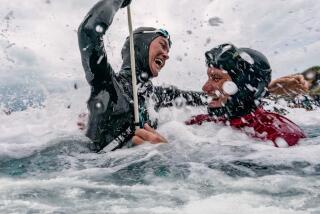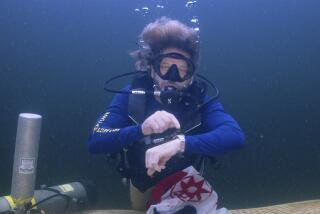PROFILE: TOM MILLINGTON : Dr. Deep : A family practitioner travels to Honduras to care for lobster divers with ‘the bends.’
- Share via
In a tiny village in southeastern Honduras, some men defy their poverty by wearing designer sunglasses, wristwatches and fancy tennis shoes. Little boys, when asked what they want to be when they grow up, usually will answer: lobster divers.
However, the Mosquito Indians in Ahuas are risking their lives for their relative affluence. Because commercial diving is unregulated in their country, divers are not formally trained and work without benefit of modern equipment. The result is that almost all have suffered from decompression sickness or “the bends,” a condition resulting from the accumulation of nitrogen bubbles in the body. The bends can occur from quick ascents or during repeated, long or deep dives.
But the situation seems to be improving thanks to the volunteer efforts of Dr. Tom Millington, a recreational diver and longtime family practitioner in Thousand Oaks who was certified in diving medicine in 1983. Earlier this year, Millington, a resident of Somis, and a fellow diver from Ventura County traveled to Ahuas to teach divers how to catch lobsters more safely.
“It’s not like I’m an Albert Schweitzer. It’s just fun to spread the word of diving safety to others,” Millington, 49, said recently as he prepared to sail to Anacapa Island for a day of diving. “After a while, you get so into diving you want people to be diving safely. You don’t want them killing themselves off.”
There are about 50 large boats near Ahuas that take about two dozen Mosquito Indians at a time on two-week treks. Once they hit a dive spot, they spread out in canoes.
Using one hand to grab the crustaceans, while the other fends off sharks with a piece of steel, divers become human underwater yo-yos: descending to catch a lobster, shooting up to the surface, dumping them in the canoe and going back down for more. This process continues until they have sucked their air tanks dry. Divers go through an average of 12 tanks a day, with some using as many as 20. Overfishing has driven them deeper for lobster; the average dive is about 120 feet.
Millington learned of the Honduran divers four years ago from Dr. Benno Marx, who runs a Moravian church clinic in Ahuas. Marx wrote to Millington after reading an article he wrote on physical exams for scuba divers.
Marx asked Millington what he, a missionary doctor, could do to help divers who would come into his clinic paralyzed from decompression sickness. A written exchange ensued that led to Millington’s securing of a re-compression chamber from Los Robles Regional Medical Center in Thousand Oaks, where he treats local divers.
Two years after Marx’s first letter, the chamber arrived in the village. Using an old air compressor from a lobster boat--with no manual or spare parts--Marx rigged up the chamber and began treating patients during the summer last year. Over the first year, he treated about 40 divers.
In February, Millington went down to check out the chamber and was amazed by what he saw.
“When you shake hands, their grips are all weak,” he said. “At first I thought, ‘These guys are a bunch of sissies.’ Then, all of a sudden, it hit me--they’ve all got it.”
Divers get the bends when nitrogen bubbles collect in ligaments and tendons around their joints, often making it painful to walk. If the bubbles reach the spinal cord or the brain, they can cause mild strokes that can result in paralysis. Stricken divers who are far from the clinic, and thus cannot be properly treated, are susceptible to infected bedsores that can be deadly.
During their trip, Millington and Tim Coates, a 44-year-old tool and die maker from Thousand Oaks and president of the Channel Islands Council of Divers, shook up a bottle of carbonated soda to illustrate how pressure builds up in the body. That may have impressed the divers, but Millington admits that he has a long way to go in educating them.
“To them, getting up with pain is a normal part of diving,” he said.
According to government medical official Dr. Lilia Larios, the Honduran government is eager for Millington and Coates to make another trip to further train the divers. Millington also hopes to bring additional re-compression chambers to Honduras.
“If they could help train some divers, it would be a blessing to the whole country,” she said. Eventually, the country hopes to regulate the lobster trade and require all divers to be formally trained, she said.
Unlike modern recreational divers, these commercial lobster divers don’t use depth gauges, watches or air-pressure gauges on their tanks, which would allow them to monitor their diving procedures and help prevent decompression sickness.
Millington and Coates said they made several suggestions to increase safety, such as using a game bag that would allow divers to hold more lobsters and make fewer trips to the surface. Yet another safety method practiced by American divers is to wait for a few minutes at 15 feet below the surface, which allows the body to release some of the excess nitrogen before surfacing. Unfortunately, most of the divers shrugged off these ideas, Millington said, fearing they would be slowed down.
The divers told the Americans that they make between $1 and $1.50 per pound of their catch. Their wages allow them to add on to their huts and perhaps have a horse and cow. The boat owner makes about six times as much on the lobster catch, most of which ends up in the United States, Millington said.
On their next trip, which is planned for some time during in the next several months, Millington and Coates plan to teach proper diving techniques to a handful of divers who in turn would teach their peers. Millington also wants to conduct studies on divers who have suffered from decompression sickness. The findings would be passed on to the Honduran government and could even be useful in treating his Ventura County patients, he said.
More to Read
Sign up for Essential California
The most important California stories and recommendations in your inbox every morning.
You may occasionally receive promotional content from the Los Angeles Times.













